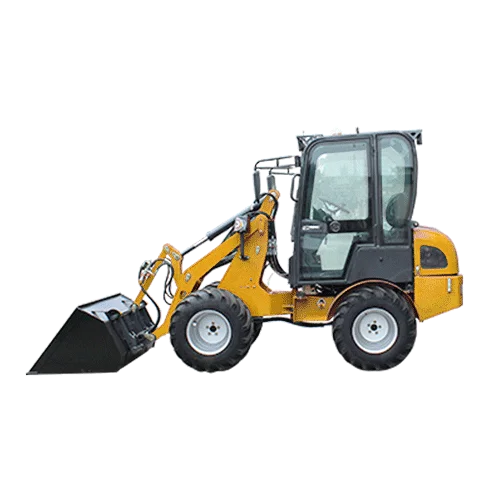Introduction

In the dynamic world of construction, the advent of loader equipment has brought about profound transformations, revolutionizing construction sites globally. This blog delves into the multifaceted aspects of loader, exploring its evolution, diverse applications, technological advancements, environmental impact, safety considerations, and future trends.
Evolution of Loader Equipment
Loader has evolved significantly from its rudimentary origins to become indispensable in modern construction. Initially characterized by basic functionalities such as material handling and earthmoving, loaders have now integrated advanced hydraulic systems, ergonomic designs, and automated features. This evolution has enhanced their versatility and efficiency across various construction tasks, from excavation and grading to debris clearance and snow removal.
Key Features and Types of Loader Equipment
Basic Features
Modern loader boasts robust features designed for efficiency and durability. Key components include a sturdy chassis that withstands rugged terrains, powerful engines for optimal performance, articulated steering for enhanced maneuverability, and versatile bucket attachments capable of quick interchangeability. These features enable loaders to tackle a wide array of tasks with precision and speed.
Types of Loader Equipment
Skid Steer Loader: Compact and agile, skid steer loaders excel in navigating confined spaces and performing intricate landscaping tasks.
Wheel Loader: Larger in size with high-capacity buckets, wheel loaders are ideal for heavy-duty earthmoving projects and bulk material handling.
Backhoe Loader: Combining the capabilities of a loader and an excavator, backhoe loaders are versatile machines suitable for digging, trenching, and loading tasks in diverse construction environments.
Compact Track Loader: Known for their stability and traction on uneven surfaces, compact track loaders excel in muddy or soft terrain conditions.
Applications of Loader Equipment in Construction
Loader plays a pivotal role across various construction sectors:
- Building Construction: Loaders are essential for transporting and placing materials like gravel, sand, and concrete during building construction.
- Road Construction: They contribute to tasks such as clearing debris, leveling surfaces, and transporting asphalt and aggregate materials.
- Landscaping: From grading and backfilling to snow removal, loaders are indispensable in creating and maintaining outdoor spaces with precision.
- Demolition: Loaders efficiently clear debris and transport rubble during demolition projects, enhancing site cleanup and efficiency.
Technological Advancements in Loader Equipment
Recent years have witnessed significant technological advancements in loader equipment:
- Telematics and GPS Integration: Real-time monitoring of equipment performance, location tracking, and maintenance scheduling to optimize operational efficiency.
- Automated Controls and Attachments: Enhanced precision and productivity through automated controls for bucket movements and attachment operations.
- Emission Control Systems: Integration of advanced exhaust filtration systems and hybrid technology to reduce environmental impact and comply with emission regulations.
Environmental Impact and Sustainability Measures
Amid increasing environmental concerns, loader manufacturers are prioritizing sustainability:
- Electric Loaders: Emerging as eco-friendly alternatives to diesel-powered machines, electric loaders significantly reduce emissions and noise pollution while improving energy efficiency.
- Fuel Efficiency: Continuous improvements in engine design and hydraulic systems to minimize fuel consumption and operational costs.
- Recyclable Materials: Utilization of recyclable materials in construction and manufacturing processes to reduce environmental footprint.
Safety Considerations and Best Practices

Safety remains paramount in loader equipment operations:
- Operator Training: Comprehensive training programs focusing on safe equipment operation, maintenance procedures, and emergency protocols.
- Safety Features: Integration of Roll Over Protective Structures (ROPS), seat belts, backup alarms, and cameras to enhance operator safety and site security.
- Regular Maintenance: Scheduled inspections, lubrication, and component checks to ensure optimal equipment performance and longevity.
Conclusion
Loader equipment stands as a cornerstone in modern construction, facilitating efficiency, safety, and sustainability across diverse project landscapes. As technological innovations continue to drive the evolution of these machines, their role in shaping the future of construction remains pivotal. By prioritizing advancements in technology, environmental responsibility, and safety protocols, loader will continue to redefine construction practices and meet the demands of tomorrow’s construction challenges.
FAQ
Q:What are the primary types of loader equipment?
A:Loader equipment includes skid steer loaders, wheel loaders, backhoe loaders, and compact track loaders, each tailored for specific construction tasks and environmental conditions.
Q:How does loader equipment contribute to construction site efficiency?
A:Loader equipment enhances efficiency by enabling quick material handling, precise grading, and versatile attachment capabilities, thus reducing project timelines and operational costs.
Q:What are the environmental benefits of modern loader equipment?
A:Modern loader equipment features eco-friendly designs such as electric and hybrid models, advanced emission control systems, and recyclable materials, promoting sustainability and compliance with environmental regulations.
Q:How important is safety in operating loader equipment?
A:Safety is paramount in loader equipment operation, with rigorous training, robust safety features, and proactive maintenance ensuring operator protection, site security, and project success.
